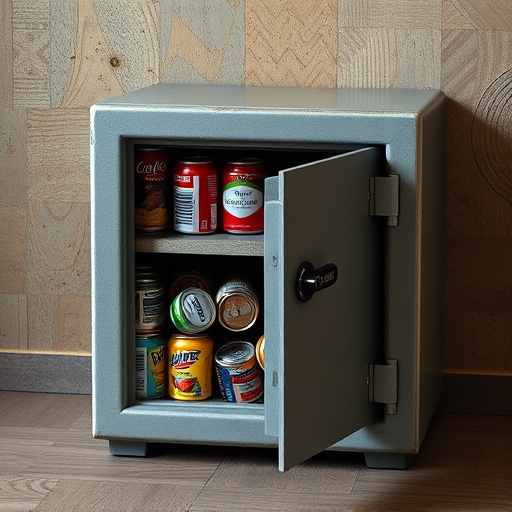In a world prioritizing personal security, hollowed-out household items like books or plant pots offer a creative and effective way to store valuable items discreetly. These secret compartments protect documents, electronics, and collectibles from burglars, ideal for travelers or high-risk areas. By transforming everyday objects into hidden spaces, individuals can enhance home security while maintaining an aesthetically pleasing environment, fostering resourcefulness in the digital age's privacy concerns.
In today’s world, ensuring personal security and privacy is paramount. This has led to a growing interest in innovative covert compartment everyday item security units—hidden storage spaces within seemingly ordinary objects. This article explores the rising demand for these discrete solutions. We delve into understanding the need for covert compartments, transforming common household items into secure enclaves, and designing effective hollowed-out item structures. Additionally, we outline best practices for discreet storage and personal safety, emphasizing the role of hollowed out household items security in modern living.
- Understanding the Need for Covert Compartments
- Common Household Items as Security Enclaves
- Designing and Implementing Effective Hollowed-Out Item Solutions
- Best Practices for Discreet Storage and Personal Safety
Understanding the Need for Covert Compartments
In today’s world, where security concerns are ever-present, individuals and organizations alike are constantly seeking innovative ways to protect their valuable items from prying eyes and theft. This is where covert compartments come into play, offering a simple yet effective solution for enhancing everyday item security. The concept is particularly appealing when considering the potential risks associated with leaving precious possessions unattended. By utilizing hollowed-out household items like books, plant pots, or even fake rocks, one can create hidden spaces to store sensitive materials securely.
These covert compartments provide an excellent means of safeguarding personal documents, small electronics, or valuable collectibles from burglars and curious onlookers. The beauty of this method lies in its discretion; what appears to be a regular household object can secretly accommodate a variety of secure storage options. This innovative approach to security is particularly beneficial for those who travel frequently or live in areas with a high risk of theft, offering peace of mind and an added layer of protection for their belongings.
Common Household Items as Security Enclaves
In today’s digital era, enhancing personal security has become paramount. One innovative approach gaining traction is the utilization of hollowed out household items as hidden security enclaves. Unsuspecting items like books, plants, or even fake rocks can be transformed into covert compartments capable of safeguarding valuable assets. This simple yet ingenious technique offers a unique solution for discreetly storing important documents, keys, or small electronic devices, ensuring they remain out of sight and reach of prying eyes.
By tapping into everyday objects, individuals can create a network of secure hiding places within their own homes. Hollowed out household items security provides an extra layer of protection, allowing people to safeguard their belongings without sacrificing aesthetics or functionality. This practical approach to security encourages creativity and resourcefulness in the face of growing concerns about privacy and safety.
Designing and Implementing Effective Hollowed-Out Item Solutions
In recent years, with an increasing awareness of personal security and privacy, there has been a growing interest in innovative hollowed-out household items security solutions. These creative approaches involve transforming everyday objects into secure compartments for storing valuable items or sensitive documents. By utilizing the natural space within common household items like books, plant pots, or even kitchen utensils, individuals can now conceal their belongings from prying eyes while maintaining accessibility.
Designing effective hollowed-out item security units requires a blend of functionality and discretion. Crafters and manufacturers must consider factors such as size, material, and method of closure to ensure the integrity and secrecy of the hidden compartment. High-quality materials like dense wood or metal can provide added protection against detection while allowing for seamless integration into everyday objects. The use of advanced locking mechanisms further bolsters security, ensuring that only authorized individuals can access the concealed space within these seemingly innocuous household items.
Best Practices for Discreet Storage and Personal Safety
When it comes to discreet storage and personal safety, utilizing hollowed-out household items as secret compartments is a creative yet effective security measure. Best practices involve selecting everyday objects that blend in naturally, such as books, plants, or even fake rocks. These items should be specifically chosen for their ability to conceal hidden spaces, ensuring they fit seamlessly into your living environment without raising suspicion.
For enhanced security, consider personalizing these compartments with secure locks and access codes. This ensures only authorized individuals can gain entry, providing an extra layer of protection for valuable items or sensitive documents. Regularly reviewing and updating storage locations and access methods is also crucial to maintaining the integrity of your hollowed-out household item security system.
In conclusion, integrating hollowed-out household items as security solutions offers a creative and discreet approach to enhancing personal safety. By understanding the need for covert compartments and leveraging everyday objects, individuals can now safeguard valuable possessions and sensitive information with greater ease. With proper design and implementation, these innovative hiding places provide an effective, yet subtle, way to protect against theft or unauthorized access. Adhering to best practices for discreet storage ensures that personal safety remains a top priority in our daily lives.
